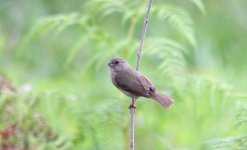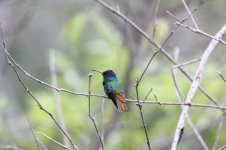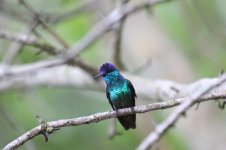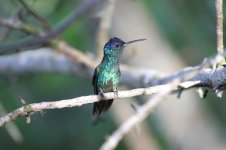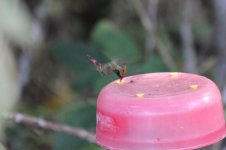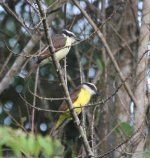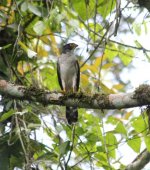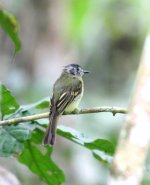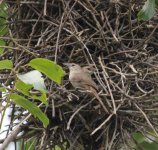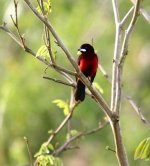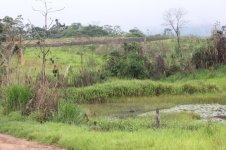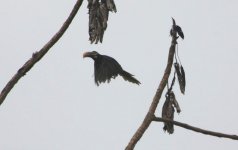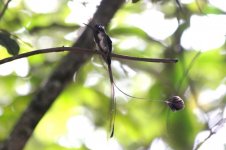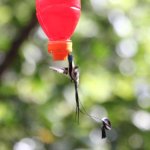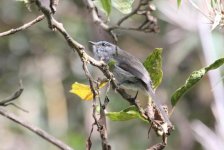ovenbird43
Well-known member

Just back from almost three weeks in Peru, the first half of the trip targeting Peruvian endemics and regional specialties in the northern Andes, the second half based in Paracas for a conference. Tropical forest birding is my absolute favorite despite its difficulty, although this trip proved more difficult than most, with certainly my all-time worst record in terms of number of targets missed. I suppose I will just have to go back!
I'll start with a summary of logistics in this post for future reference for anyone planning a similar trip.
Itinerary Overview:
Oct 30: Flight from US to Lima, even flight to Tarapoto
Oct 31: travel to Moyobamba, visit Waqanki Reserve
Nov 1: all day Waqanki
Nov 2: travel to Pomacochas, evening Huembo for Marvelous Spatuletail
Nov 3: San Lorenzo crest trail for Pale-billed Antpitta and other specials
Nov 4: Fundo Alto Nieva
Nov 5; Fundo Alto Nieva
Nov 6: return to Tarapoto
Nov 7: birding Cordillera Escalera, evening flight to Lima
Nov 8: travel to Paracas
Nov 9 - Nov 15: Paracas, conference and birding, incl. organized day trip into Andes
Nov 16: travel to Lima, fly home next day
Trip Planning:
I did this trip alone, without professional guides. My primary resource for planning was http://www.perubirds.org/rutas.shtml; the website is in Spanish but individual site pages have an option to translate everything in English or other languages. For getting around, I downloaded the Android app GeoNet which included an in-app option to purchase detailed maps of Peru ($20), which I found very helpful - the map includes many trails and feeder locations and does not require cell service or data for navigation.
Transportation:
I used Peruvian Airlines for the Lima-Tarapoto flights, cost was around $110 (USD) one-way, and they make you store everything in the overhead bins (nothing allowed under the seat in front of you). For getting around northern Peru, there are very few traditional buses but plenty of van "colectivos" that were fast and economical, as well as collective cars run by Turismo Cajamarca that were a bit more pricey but not bad. Mototaxis were plentiful in all of the towns. I found it easy to get from towns to anywhere, but getting a ride back once away from the towns was not always easy or fast. To do this route thoroughly, one really needs private transportation (or a lot more time) - there were several good spots I had to skip because there just wasn't a good way to get there and/or back without having to wait a few hours for transportation.
Lodging:
Hospedaje Omaguas in Tarapoto - one night. Cheap ($16) and basic. There are better options even in the same price range.
Casa de Seizo - Set behind the thermal baths outside Moyabamba and a 15-minute walk from Waqanki. ($21/night) Very nice accommodations with good bird activity around their tilapia ponds, including Band-bellied Owls at night.The hosts were wonderful and offer delicious lunch or dinner for $6.
Lago Azul, Pomacochas - good accommodations for ~$11/night. Free wifi although it kept going out - fortunately the router was right by my room so I just reset it anytime it needed.
Fundo Alto Nieva - rustic cabins for $40/night, which includes hot breakfast and guided viewing of Long-whiskered Owlet and the antpittas (Ochre-fronted and Rusty-tinged). My favorite place of all.
Bambu Tarapoto - hostel, I booked a private room for $12. Enjoyable, the hosts were pleasant and accommodating, would stay again.
Kurmi Airport Hostel - Lima. $11. Surprisingly nice given the price and not-so-nice location (convenient to the airport though, about 10-15 minute drive). I took the offer for direct transportation to and from the airport, roundtrip 50 soles or $15. Rooms were large and clean, the area was quiet, I lucked out and had the room to myself even though I had only booked a bed in a dorm.
Atenas Backpackers Hospedaje, Paracas - booked a bed in a dorm for $64 for the entire 8-day stay. Great value, the place is clean and very well-run, generally quiet, very nice hosts, option for bicycle rental.
Villa La Punta, Lima - $35 a night, very nice location on the point of Callao, a nice alternative to Miraflores if wanting to stay closer to the airport. Wonderful host and accommodations, breakfast included.
I'll start with a summary of logistics in this post for future reference for anyone planning a similar trip.
Itinerary Overview:
Oct 30: Flight from US to Lima, even flight to Tarapoto
Oct 31: travel to Moyobamba, visit Waqanki Reserve
Nov 1: all day Waqanki
Nov 2: travel to Pomacochas, evening Huembo for Marvelous Spatuletail
Nov 3: San Lorenzo crest trail for Pale-billed Antpitta and other specials
Nov 4: Fundo Alto Nieva
Nov 5; Fundo Alto Nieva
Nov 6: return to Tarapoto
Nov 7: birding Cordillera Escalera, evening flight to Lima
Nov 8: travel to Paracas
Nov 9 - Nov 15: Paracas, conference and birding, incl. organized day trip into Andes
Nov 16: travel to Lima, fly home next day
Trip Planning:
I did this trip alone, without professional guides. My primary resource for planning was http://www.perubirds.org/rutas.shtml; the website is in Spanish but individual site pages have an option to translate everything in English or other languages. For getting around, I downloaded the Android app GeoNet which included an in-app option to purchase detailed maps of Peru ($20), which I found very helpful - the map includes many trails and feeder locations and does not require cell service or data for navigation.
Transportation:
I used Peruvian Airlines for the Lima-Tarapoto flights, cost was around $110 (USD) one-way, and they make you store everything in the overhead bins (nothing allowed under the seat in front of you). For getting around northern Peru, there are very few traditional buses but plenty of van "colectivos" that were fast and economical, as well as collective cars run by Turismo Cajamarca that were a bit more pricey but not bad. Mototaxis were plentiful in all of the towns. I found it easy to get from towns to anywhere, but getting a ride back once away from the towns was not always easy or fast. To do this route thoroughly, one really needs private transportation (or a lot more time) - there were several good spots I had to skip because there just wasn't a good way to get there and/or back without having to wait a few hours for transportation.
Lodging:
Hospedaje Omaguas in Tarapoto - one night. Cheap ($16) and basic. There are better options even in the same price range.
Casa de Seizo - Set behind the thermal baths outside Moyabamba and a 15-minute walk from Waqanki. ($21/night) Very nice accommodations with good bird activity around their tilapia ponds, including Band-bellied Owls at night.The hosts were wonderful and offer delicious lunch or dinner for $6.
Lago Azul, Pomacochas - good accommodations for ~$11/night. Free wifi although it kept going out - fortunately the router was right by my room so I just reset it anytime it needed.
Fundo Alto Nieva - rustic cabins for $40/night, which includes hot breakfast and guided viewing of Long-whiskered Owlet and the antpittas (Ochre-fronted and Rusty-tinged). My favorite place of all.
Bambu Tarapoto - hostel, I booked a private room for $12. Enjoyable, the hosts were pleasant and accommodating, would stay again.
Kurmi Airport Hostel - Lima. $11. Surprisingly nice given the price and not-so-nice location (convenient to the airport though, about 10-15 minute drive). I took the offer for direct transportation to and from the airport, roundtrip 50 soles or $15. Rooms were large and clean, the area was quiet, I lucked out and had the room to myself even though I had only booked a bed in a dorm.
Atenas Backpackers Hospedaje, Paracas - booked a bed in a dorm for $64 for the entire 8-day stay. Great value, the place is clean and very well-run, generally quiet, very nice hosts, option for bicycle rental.
Villa La Punta, Lima - $35 a night, very nice location on the point of Callao, a nice alternative to Miraflores if wanting to stay closer to the airport. Wonderful host and accommodations, breakfast included.




